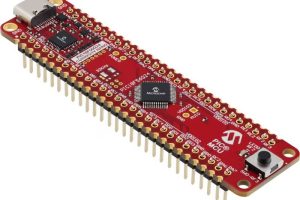
Called ‘SparkFun Digi XBee development board’, it is designed for prototyping cellular IoT applications using one of several Digi’s XBee wireless modules – the socket footprint is Digi’s 13 x 19mm XBee 3 micro form factor – in particular the XBee 3 LTE-M/NB-IoT (below left), which has a GNSS satellite navigation receiver alongside its communication transceivers.

“This is a kitchen sink development board that gives you access to the pin functionality of the XBee, includes two USB-C connectors for UART communication and firmware updates, a Qwiic connector for I2C capable sensors and peripherals, as well as reset and D0 buttons, and the ability to update firmware on the XBees that have cellular modules,” said SparkFun. “There’s also a JST port for a battery to allow your project to be more on the go.” – Qwicc is SparkFun’s 3.3V I2C-based peripheral bus which is standardised around 4pin 1mm pitch connectors from JST’s SH series – It is daisy-chainable to over 100 clients and there are scores of compatible boards.
5V power can enter through either USB socket, and there is a AP63203 buck converter on-board to deliver 3.3V at up to 2A, plus a 500mA Li-po charger. USB to UART bridging is handled by an FT231XS.
“The combination of these technologies brings I2C-based rapid-prototyping tools to a wide range of users, from hobbyists to professional R&D developers, who are looking to integrate cellular IoT from sensor to cloud,” said distributor Symmetry Electronics, which has just signed-up to stock both Digi International and SparkFun products.
Digi’s remote manager can be used to configure and control devices from a central platform, while its “TrustFence security, identity and data privacy features use multiple layers of control to protect against new and evolving cyber threats”, claimed SparkFun.
XBee API frames and AT commands, Digi’s XCTU (Windows, MacOS and Linux confiuration tool) and MicroPython can be used for set-up, testing and altering function.
 Electronics Weekly Electronics Design & Components Tech News
Electronics Weekly Electronics Design & Components Tech News



